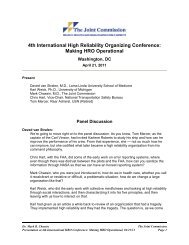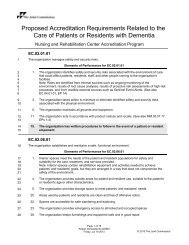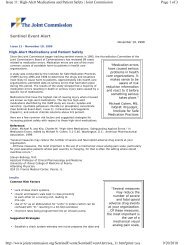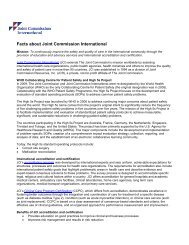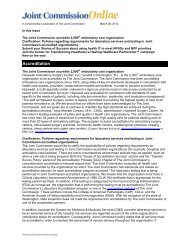Keeping Your Hospital Property Smoke-Free ... - Joint Commission
Keeping Your Hospital Property Smoke-Free ... - Joint Commission
Keeping Your Hospital Property Smoke-Free ... - Joint Commission
Create successful ePaper yourself
Turn your PDF publications into a flip-book with our unique Google optimized e-Paper software.
KEEPING YOUR HOSPITAL PROPERTY SMOKE-FREE:<br />
Successful Strategies for Effective Policy Enforcement and Maintenance<br />
Case Examples: One small hospital in a rural<br />
setting understood that when smokers quit, they<br />
often experience a subsequent weight gain.<br />
The hospital therefore included in its employee<br />
wellness incentive program a 20-pound “credit”<br />
to those who quit smoking. That way, they<br />
reasoned, even if employees gained a little<br />
weight on their way to a tobacco-free lifestyle,<br />
they would still be recognized for their efforts<br />
and receive the benefit of the incentive. This<br />
demonstrated the hospital administration’s<br />
understanding and compassion for those who<br />
undertook this crucial lifestyle behavior change.<br />
Similarly, at a large healthcare organization in an<br />
urban setting, the smoke-free policy opened the<br />
door to other hospital-wide health initiatives. The<br />
wellness project that followed on the heels of the<br />
smoke-free property policy introduced healthier<br />
meal options in the cafeteria.<br />
Collaborate with other organizations and local<br />
government entities in your community.<br />
When the policy is similar at all health care organizations in<br />
the area, it's that much easier for everyone to comply — and<br />
no one can claim any competitive advantage. Collaborating<br />
with other healthcare organizations will likely garner you<br />
heightened media attention, and that attention will be<br />
much more positive when a united front is presented. Some<br />
organizations even agree to use similar language both in<br />
their policies and on signage.<br />
This is also an excellent time to reach out to public health<br />
and prevention-oriented organizations, to ask for their<br />
assistance and join in their efforts to reduce tobacco use.<br />
Local ordinances may be useful in encouraging compliance,<br />
especially in public areas adjacent to your property. If<br />
smoking near perimeters or on public sidewalks is an issue,<br />
work with your local government to see if an ordinance<br />
can be adopted to bolster your policy and its enforcement.<br />
Enlisting community support for tobacco prevention and<br />
control through a variety of venues will help promote<br />
a consistent message. Be an active player in your local<br />
tobacco control coalition, and community members will<br />
see that you are addressing the issue from several angles.<br />
Form a task force dedicated to enforcement which<br />
includes smokers in the planning and implementation.<br />
Most organizations form at least one task force to direct<br />
the overall policy development and implementation, along<br />
with subcommittees to address specific issues. Consider<br />
forming a team specifically dedicated to enforcement.<br />
If possible, maintain your enforcement task force as a<br />
standing committee after the policy is in place, so that<br />
progress in policy implementation and enforcement can<br />
be monitored and procedures can be modified as needed.<br />
It is important to have smokers and former smokers<br />
well-represented on these committees. This helps to<br />
ensure the policy and the support services you offer<br />
will meet smokers’ needs, and eases concerns that the<br />
policy will be punitive. The smokers on the committee<br />
will know where problem areas are likely to be and what<br />
kind of resistance may be encountered.<br />
In fact, during planning, consider forming an “allsmokers”<br />
committee to test out different aspects of<br />
the policy, including the resources and programs you<br />
plan to offer to employees, patients and visitors who<br />
smoke. These committee members may later become the<br />
champions of the policy among smokers, and often go<br />
on to become ex-smokers.<br />
7



